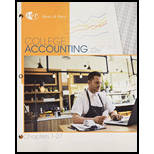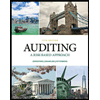
Compute cash from operating activities under the direct and indirect methods.
Explanation of Solution
Statement of
Direct method: Under direct method, cash receipts from customers (
Operating activities: Operating activities include cash inflows and outflows from business operations.
The below table shows the way of calculation of cash flows from operating activities using direct method:
| Cash flows from operating activities (Direct method) |
| Add: Cash receipts. |
| Cash receipt from customer |
| Dividend received |
| Interest received |
| Less: Cash payments: |
| To supplier for acquisition of inventory |
| To employees |
| For interest on loans |
| Income tax expenses and other operating expenses |
| Net cash provided from or used by operating activities |
Table (1)
Indirect method: Under indirect method, net income is reported first, and then non-cash expenses, losses from fixed assets, and changes in opening balances and ending balances of current assets and current liabilities are adjusted to reconcile the net income balance.
Cash flows from operating activities: Operating activities refer to the normal activities of a company to carry out the business.
The below table shows the way of calculation of cash flows from operating activities using indirect method:
| Cash flows from operating activities (Indirect method) |
| Net income: |
| Add: Decrease in current assets |
| Increase in current liability |
| |
| Loss on sale of plant assets |
| Deduct: Increase in current assets |
| Decrease in current liabilities |
| Gain on sale of plant assets |
| Net cash provided from or used by operating activities |
Table (2)
Compute cash from operating activities under the direct method:
| Statement of Cash Flows Direct Method (Partial) | ||
| Details | Amount ($) | Amount ($) |
| Cash flows from operating activities: | ||
| Cash receipts: | ||
| Cash received from customers | 530 | |
| Total cash receipts | 530 | |
| Cash payments: | ||
| Cash paid to employees | (350) | |
| Total cash payments | (350) | |
| Net cash provided by operating activities | $180 | |
Table (3)
Working notes:
Calculate the amount of cash received from customers:
Calculate the amount of cash paid to employees:
Compute cash from operating activities under the indirect method:
| Statement of Cash Flows - Indirect Method | ||
| Details | Amount ($) | Amount ($) |
| Cash flows from operating activities: | ||
| Net Income | 200 | |
| Adjustment to reconcile net income to net cash provided by operating activities: | ||
| Changes in current assets and current liabilities: | ||
| Decrease in | 30 | |
| Decrease in wages payable | (50) | (20) |
| Net cash provided by operating activities | $180 | |
Table (4)
Working note:
Calculate the amount of net income:
Therefore, the net cash flows from operating activities under the direct and indirect method are $180.
Want to see more full solutions like this?
Chapter 23 Solutions
Bundle: College Accounting, Chapters 1-27, Loose-Leaf Version, 22nd + CengageNOWv2, 2 terms Printed Access Card
 Managerial AccountingAccountingISBN:9781337912020Author:Carl Warren, Ph.d. Cma William B. TaylerPublisher:South-Western College Pub
Managerial AccountingAccountingISBN:9781337912020Author:Carl Warren, Ph.d. Cma William B. TaylerPublisher:South-Western College Pub Managerial Accounting: The Cornerstone of Busines...AccountingISBN:9781337115773Author:Maryanne M. Mowen, Don R. Hansen, Dan L. HeitgerPublisher:Cengage Learning
Managerial Accounting: The Cornerstone of Busines...AccountingISBN:9781337115773Author:Maryanne M. Mowen, Don R. Hansen, Dan L. HeitgerPublisher:Cengage Learning Auditing: A Risk Based-Approach (MindTap Course L...AccountingISBN:9781337619455Author:Karla M Johnstone, Audrey A. Gramling, Larry E. RittenbergPublisher:Cengage Learning
Auditing: A Risk Based-Approach (MindTap Course L...AccountingISBN:9781337619455Author:Karla M Johnstone, Audrey A. Gramling, Larry E. RittenbergPublisher:Cengage Learning Cornerstones of Financial AccountingAccountingISBN:9781337690881Author:Jay Rich, Jeff JonesPublisher:Cengage Learning
Cornerstones of Financial AccountingAccountingISBN:9781337690881Author:Jay Rich, Jeff JonesPublisher:Cengage Learning Financial Accounting: The Impact on Decision Make...AccountingISBN:9781305654174Author:Gary A. Porter, Curtis L. NortonPublisher:Cengage Learning
Financial Accounting: The Impact on Decision Make...AccountingISBN:9781305654174Author:Gary A. Porter, Curtis L. NortonPublisher:Cengage Learning





